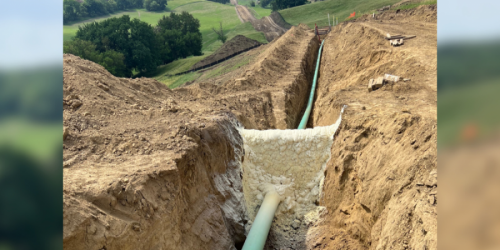Q&A Forums
ICC and ICC-ES Post New Topic | Post Reply
| Author | Comments |
|---|---|
|
jimcoler
Posted: Mar 05, 2011 12:05 PM
|
ICC and ICC-ES
Mason, So, what is the difference between the ICC and the ICC-ES? As I understand it from a code engineer, the ICC-ES doesn't have any authority to establish or change any codes written in the ICC. That being said, how does AC-377 have any reference to what we do and the code complaince? Just a thought? Jim |
|
mason
Posted: Mar 06, 2011 09:20 AM
|
Think of ICC as developing the regulations with prescriptive language that a code official can follow to determine if you comply with the code. It tells you how much R value to use in different climates zones, types of vapor retarders and how they can be used and the specific items that are code designated as thermal or igntion barriers. Code officials like to use the prescriptive portion of the code because it is easy to follow based on observations. For example, if your foam has an R value of 6 per inch and the code table prescribes R 13 in your region, then you would need 2.1 inches of foam to comply. But, the codes also allow you to use that the material or assembly not specifically listed in the code. This is called the performance section of the code allowing for alternative products or assemblies that demonstrate equal or better performance than the code designated products. Then the ICC ES comes into play. Call them the referees of the code world. They are not a part of ICC but they have been designated by ICC to be the official folks that can provide opinions on the use of materials, design and assemblies that are not specifically covered in the codes. The opinions are the evaluation reports issued by ICC-ES. AC 377 and other acceptance criteria form the rules that the ICC ES engineers use to evaluate the assemblies or products for their performance in relationship to the prescriptive codes. ACC 377 can be used by manufacturers to produce data that is sent to the ICC ES engineers so they can make determinations if an assembly, product etc complies with the spirit of the codes as a "alternative" to the building codes. That is why AC 377 is important to the industry, it allows foam to be installed without thermal or ignition barriers so long as it passes the tests designated in the AC 377. The information is provided to the manufacture (and the public) in the form of an evaluation report. It contains the type of products, what it used for, what tests were conducted, and what exceptions to the prescribed code it relates to. (such as using bare foam in attics or crawl spaces) Most code officials accept an ICC ES evaluation report without question. A few would still insist of the prescriptive language of the code. |
|
jimcoler
I have over 10 years of experience specifying and installing open and closed cell spray foam. I've sold my business but I'm still selling for the new owners and consulting on large and custom specific jobs. I've expanded my knowledge into t Posted: Mar 06, 2011 05:01 PM
|
So, that's what I thought you would say, but that doesn't explain how the ICC can write in the code, tested in "...actual end use configuration." but the ICC-ES can do a test which is not compliant with this requirement! An 8' high x8' wide x 12' deep room withn one side wide open is not "actual end use configuration"! As a matter of fact, the last time I tried to pass an 8' crawlspace using this, I was denied because they have a separate section in the code for basements or the last time I tried to pass an 8' high flat ceiling attic, they said "NO" because there is a separate section of the code for thrid stories. So, This "Modified NFPA 286 test" is not an "Actual end use configuration!" So, which one do we go by? The ICC or ICC-ES???? Which one has the over ruling decision? Because the ICC says it needs to be tested in compliance with actual end use configuration, but the ICC-ES states that an 8' high room test with one end open meets this need, but it doesn't! Now do you see why I asked this question? |
|
mason
Posted: Mar 07, 2011 09:32 AM
|
I assumed your question was addressing the relative authority of each group. What really matters is what does your local code official or local authority having code jurisdiction use to accept an assembly that is not specifically listed in the code. (such as a sprayfoam with less R value than the prescriptive tables or using foam without an ignition barrier). Some code officials are secure in their ability to understand the various types of fire and thermal performance tests and will use logic and common sense to make a determination. They may accept an assembly that does not have a ICC-ES evalaution report and would use the data supplied from tests that replicate the real world. However it is my experience that most code officials do not have the background, knowledge or experience to be able to differentiate among the dozens of ways the test can be performed and will instead go by the strict language of the codes or the ICC ES evaluation reports. I seldom see a code official that will not accept a ICC ES report and the ICC endorses the reports as well. |
|
jimcoler
I have over 10 years of experience specifying and installing open and closed cell spray foam. I've sold my business but I'm still selling for the new owners and consulting on large and custom specific jobs. I've expanded my knowledge into t Posted: Mar 11, 2011 06:52 AM
|
I agree about many of them not knowing any different. It's taken me quite a while to understand what I do, and still takes time as the industry is contantly changing. I understand about the local code official and their tendancy to just go with the ICC and ICC-ES, but what is the relationship here, because most people don't know it and have asked the question only to find, there isn't an answer or they haven't been given one that's acceptable. You hit the nail right on the head. R-value is one of our biggest battles along with fire situations. I think Roger Morrison's article on the Effective thickness of spray foam has help me in the industry and helped others understand hwo much is enough. A good start to the R-value battle! So, just going by what the code or ICC-ES says isn't always correct! Many times it seems like they are getting paid under the table by someone and why would they want to make things worse for their pocket when they can make it better without too much push back from the industry? |





























